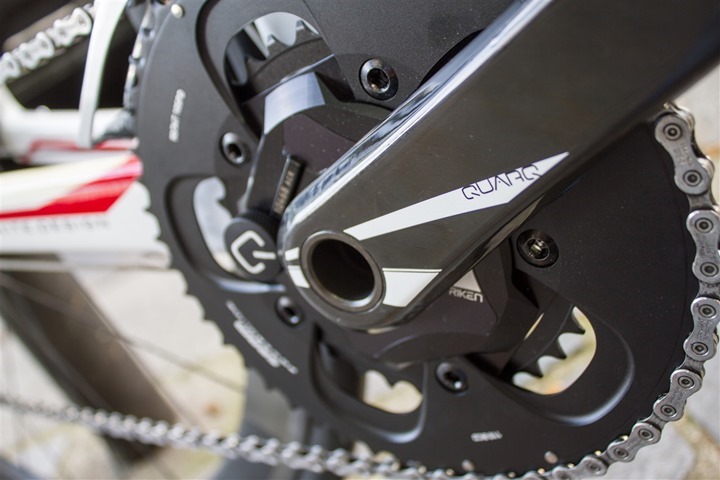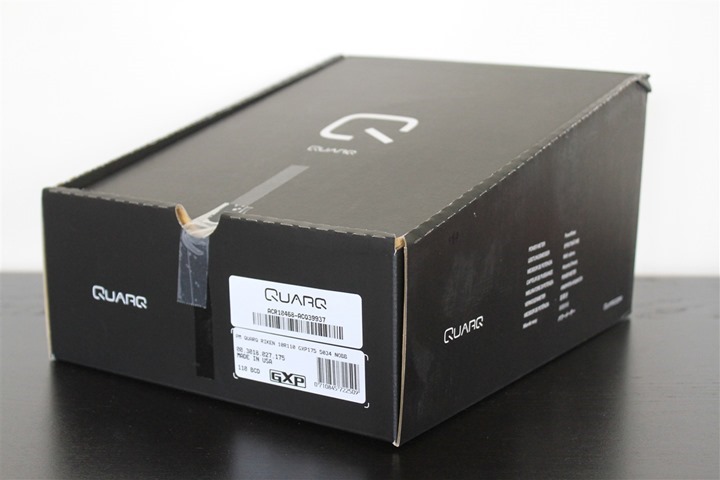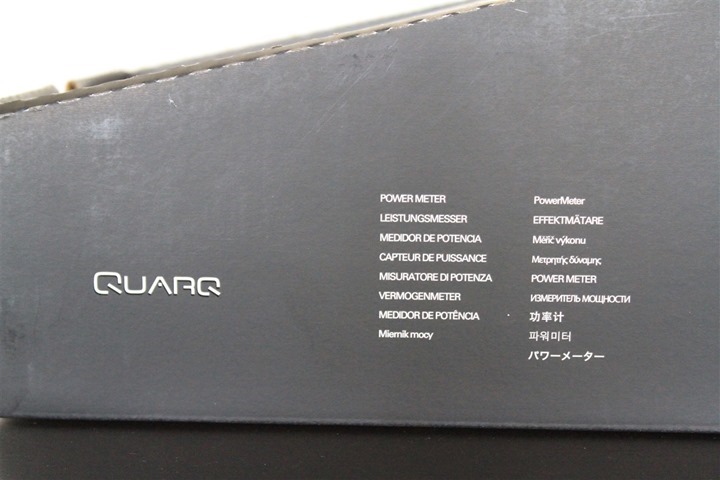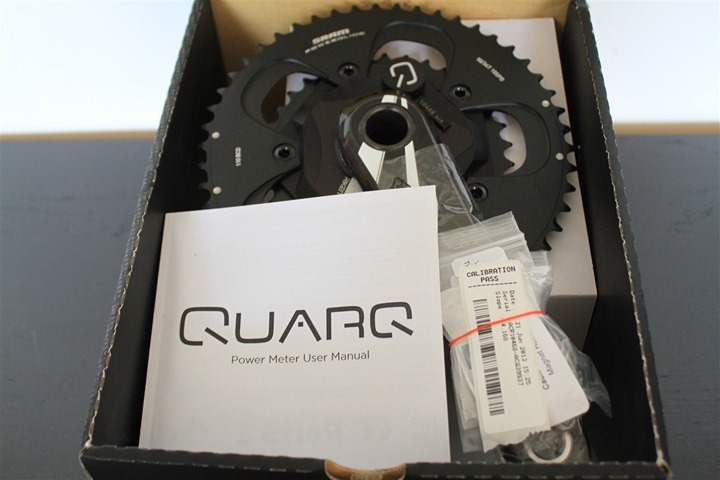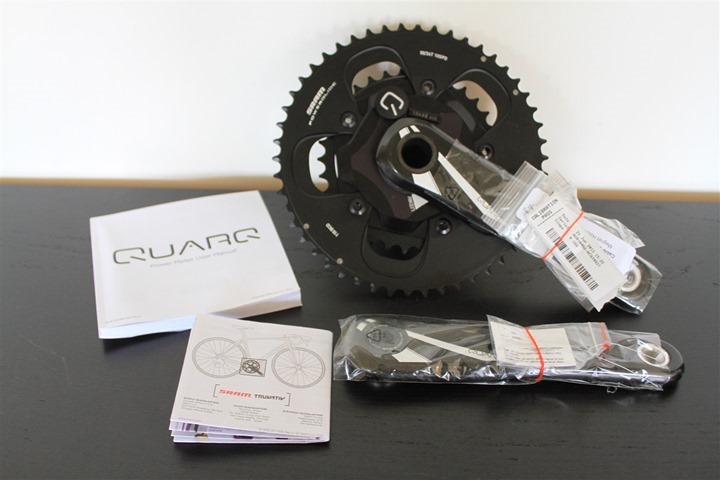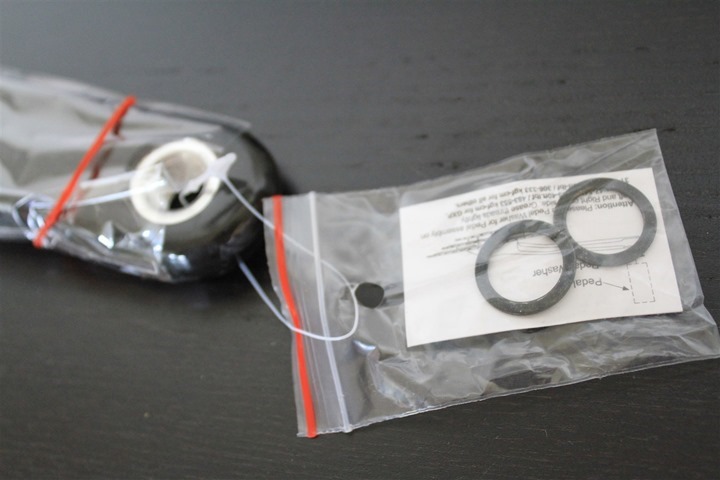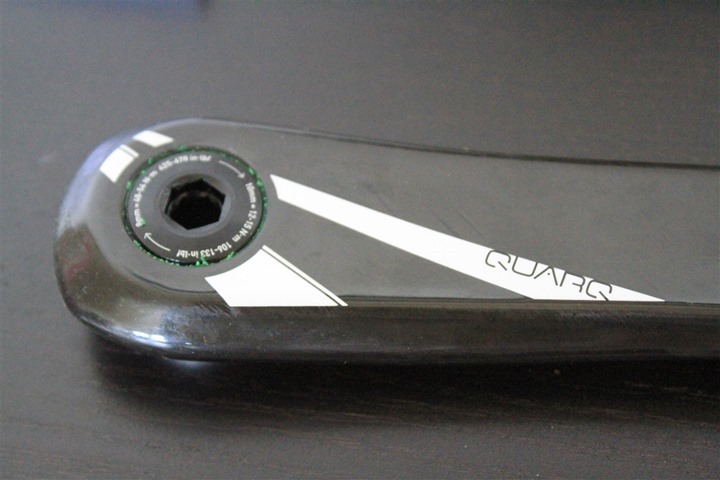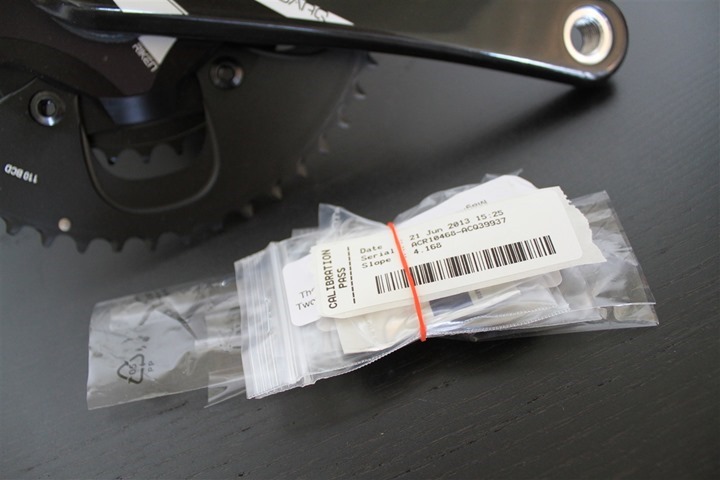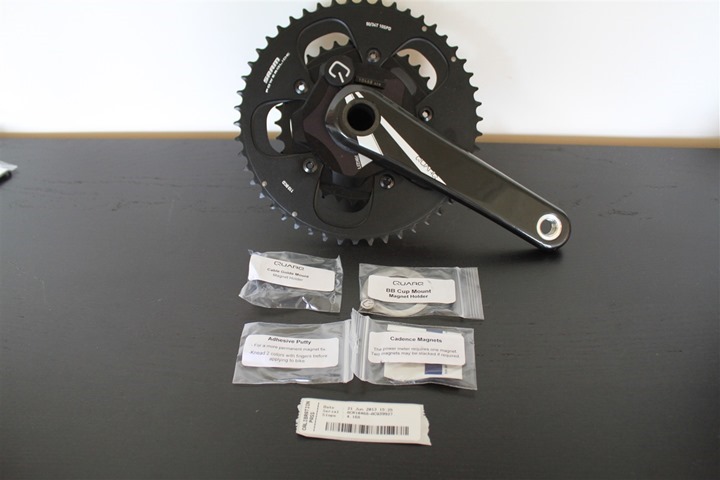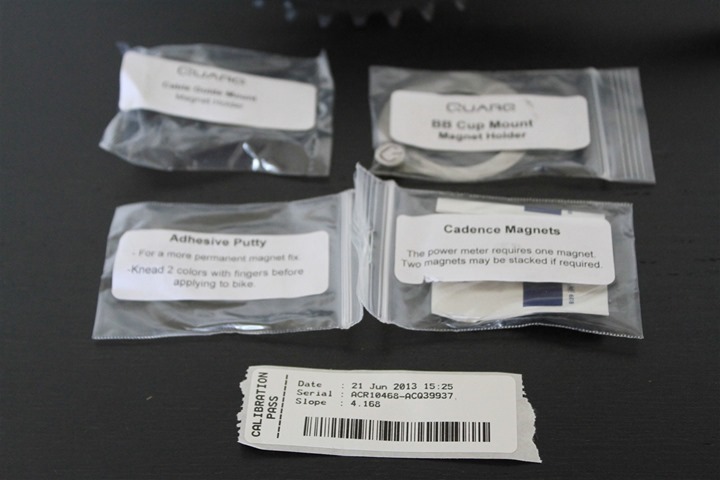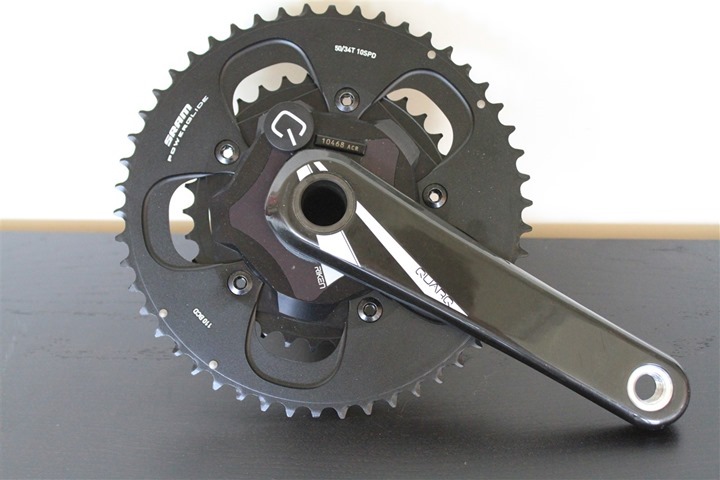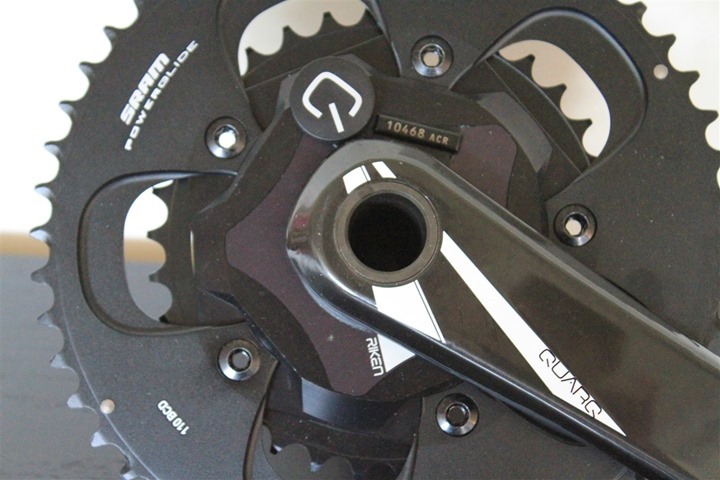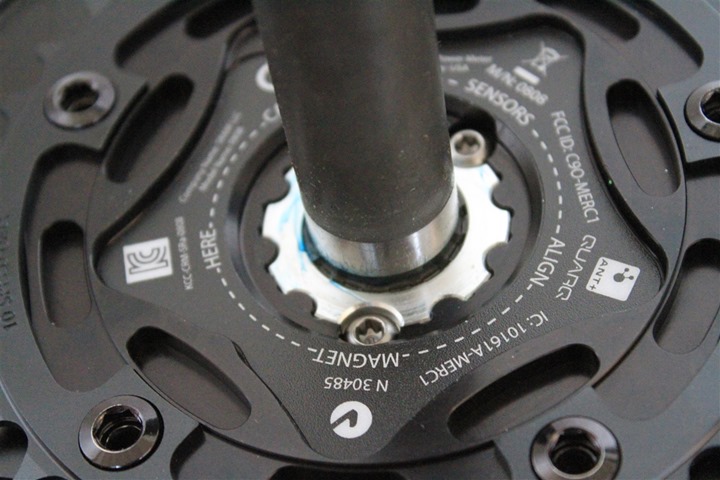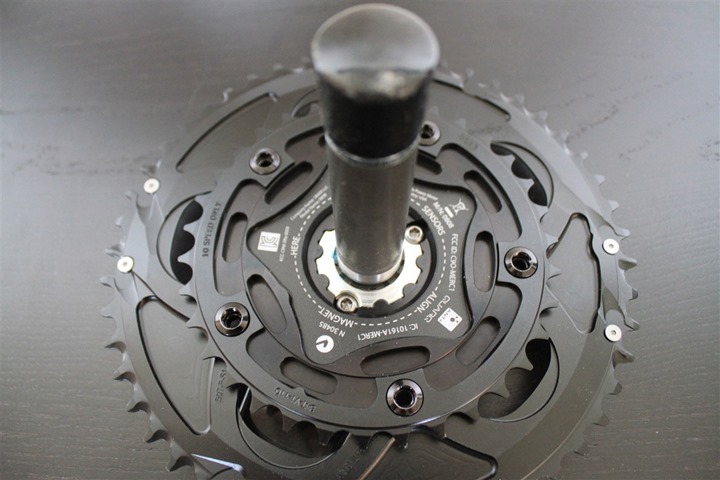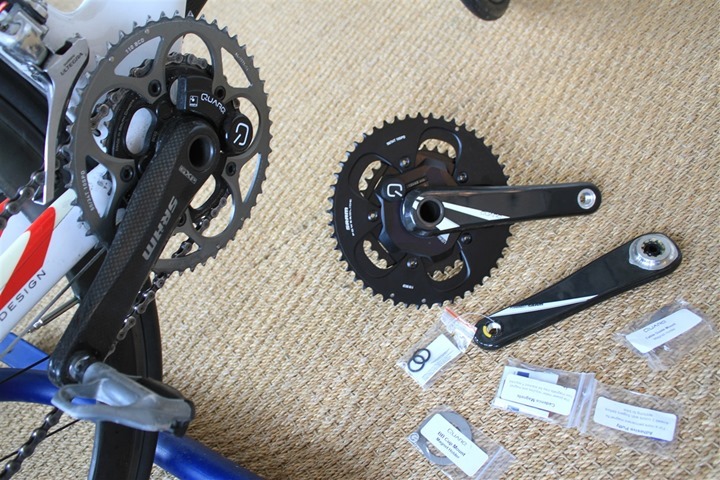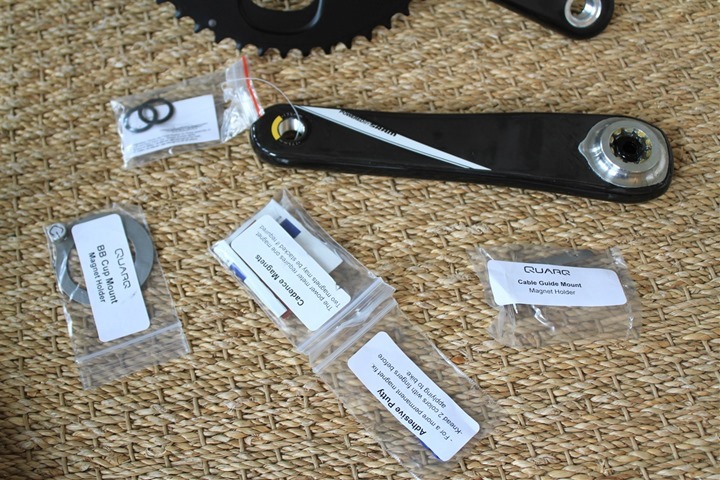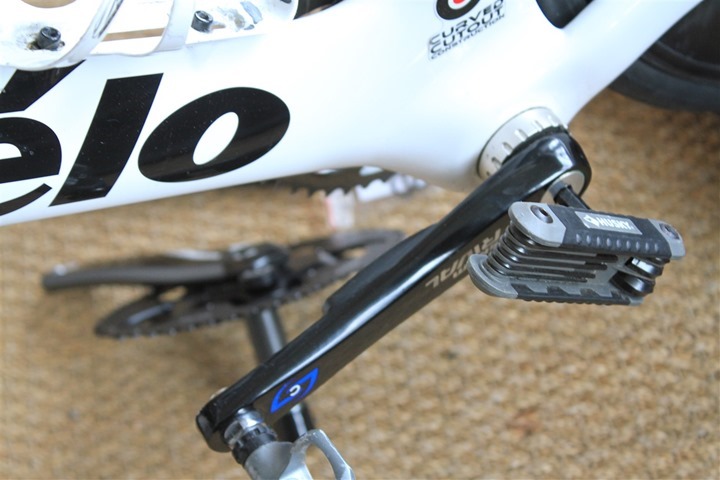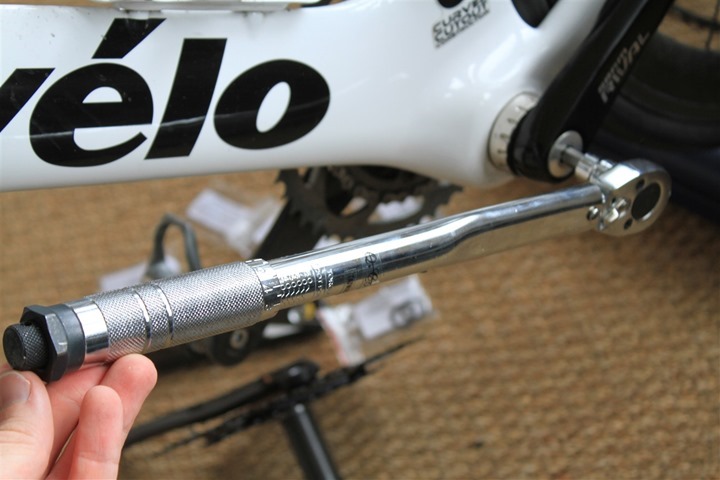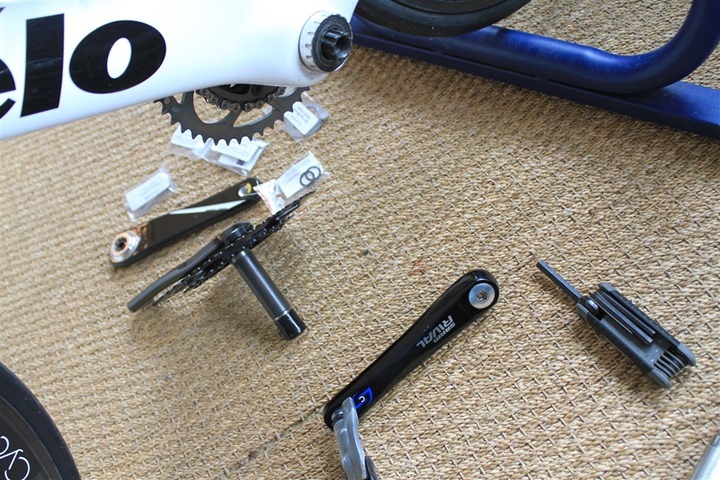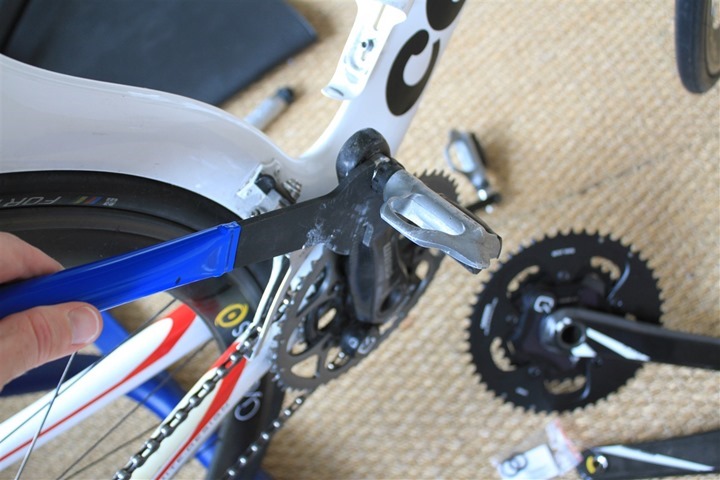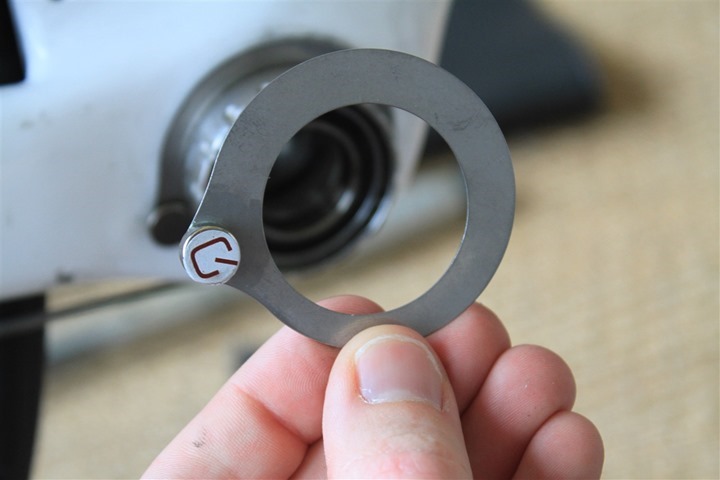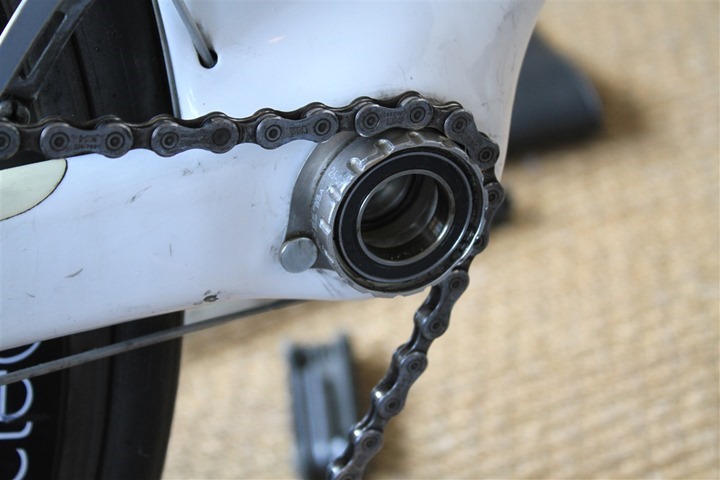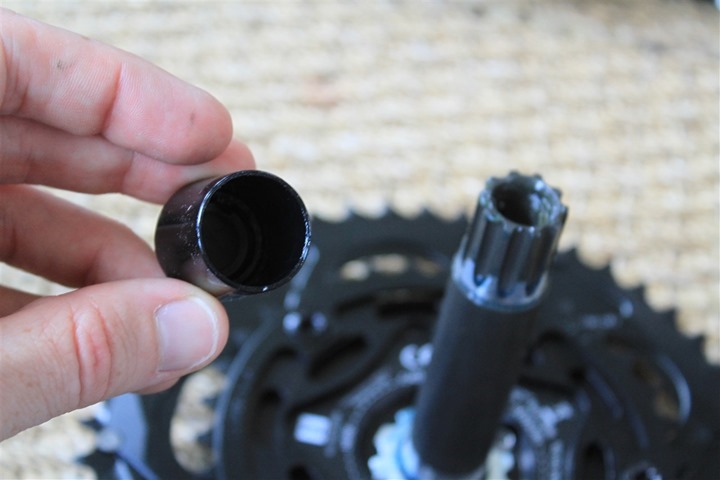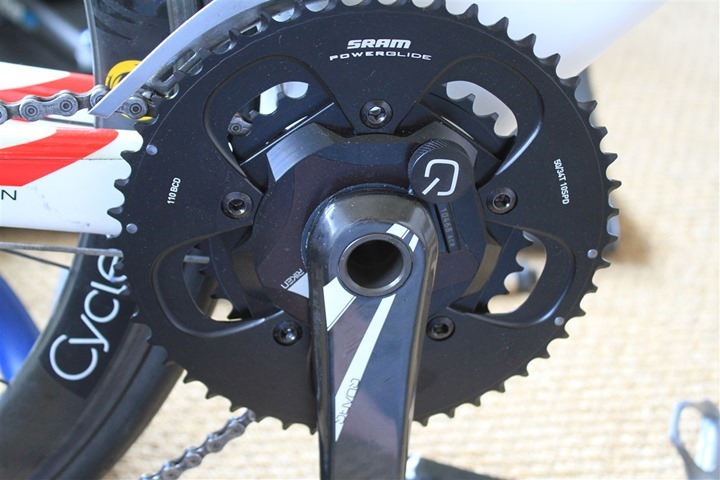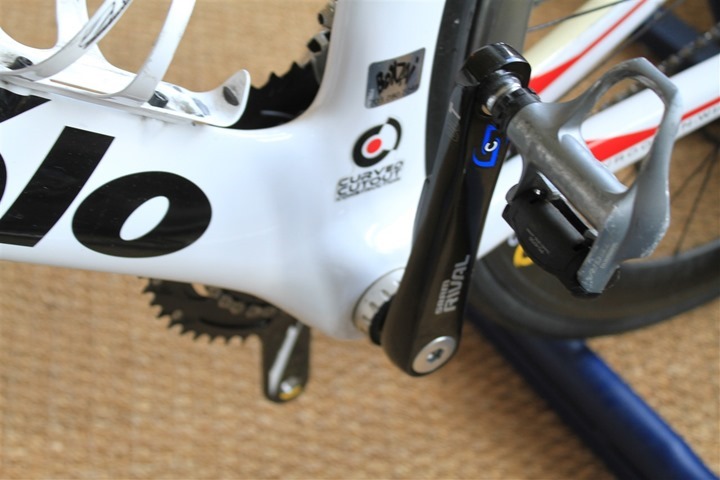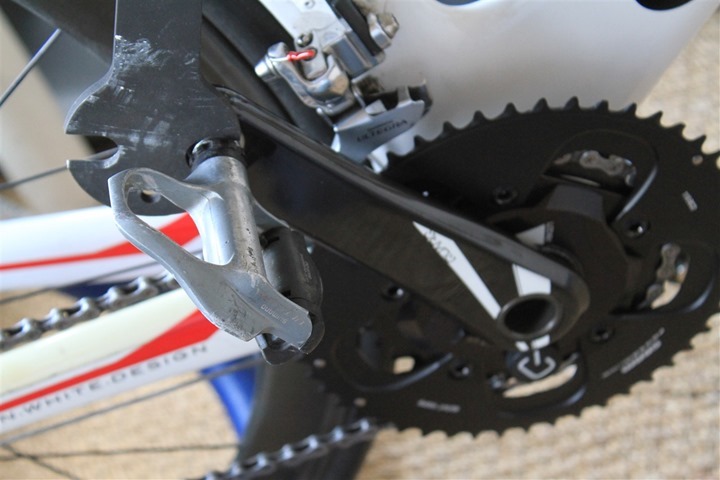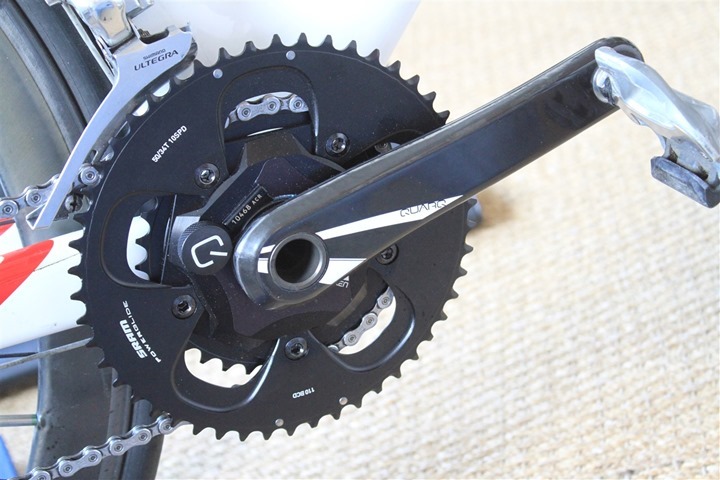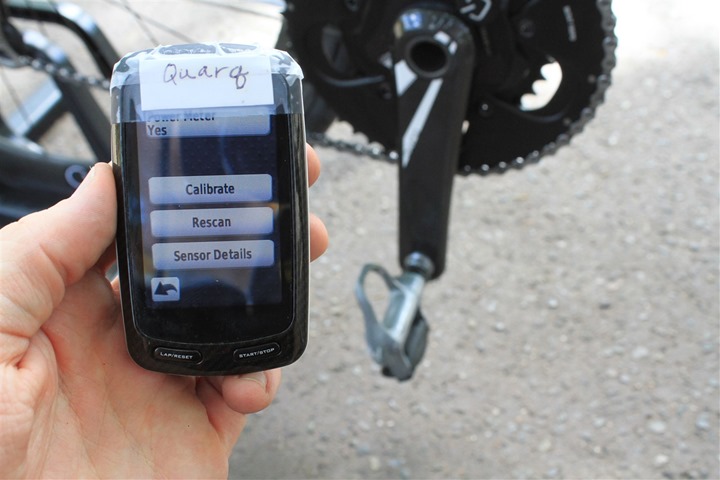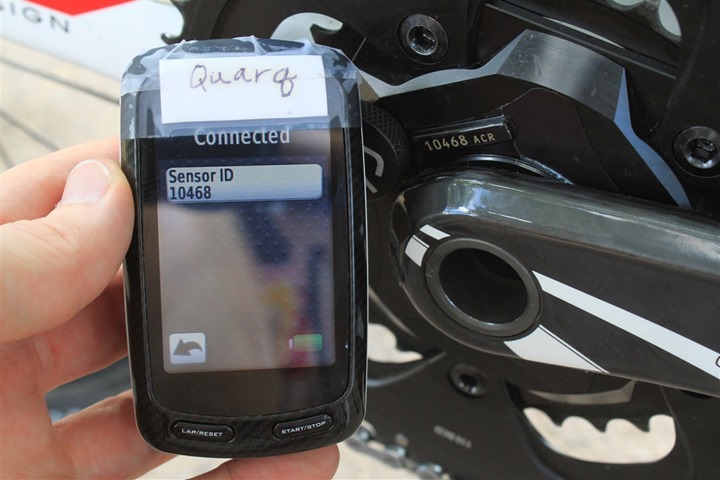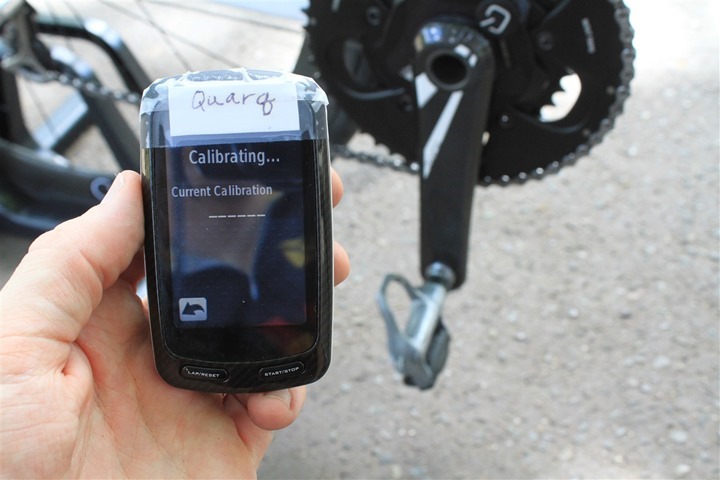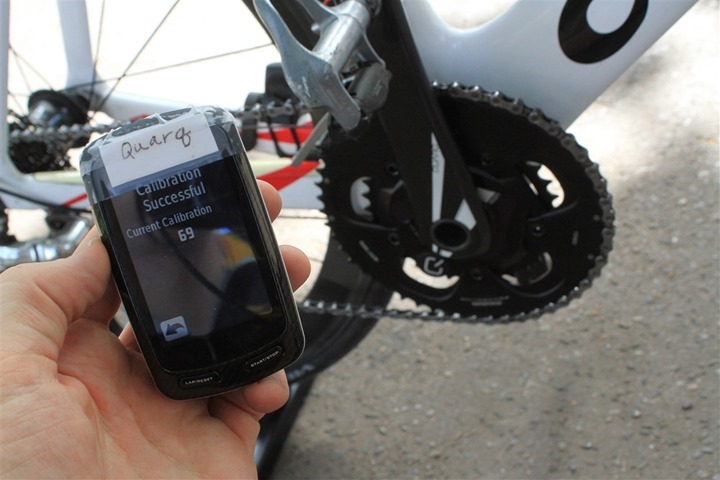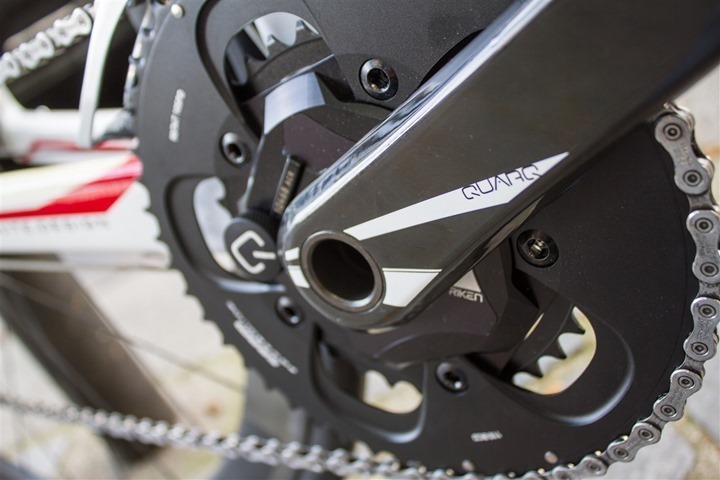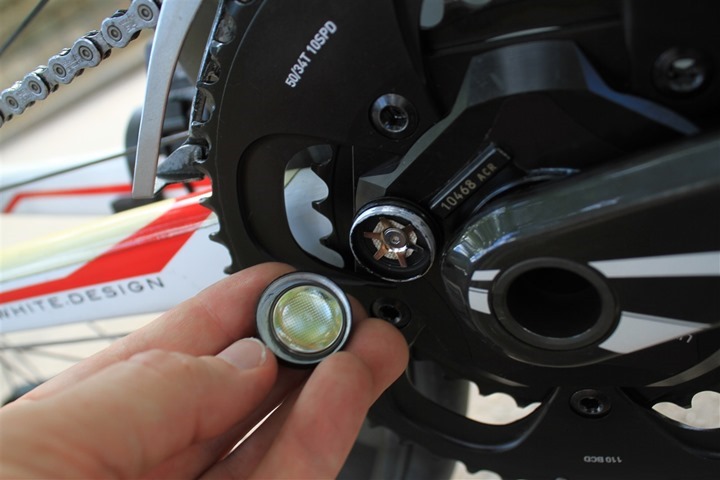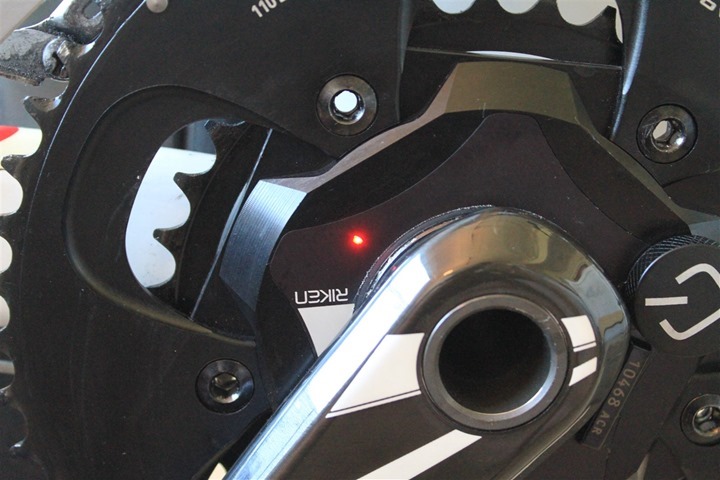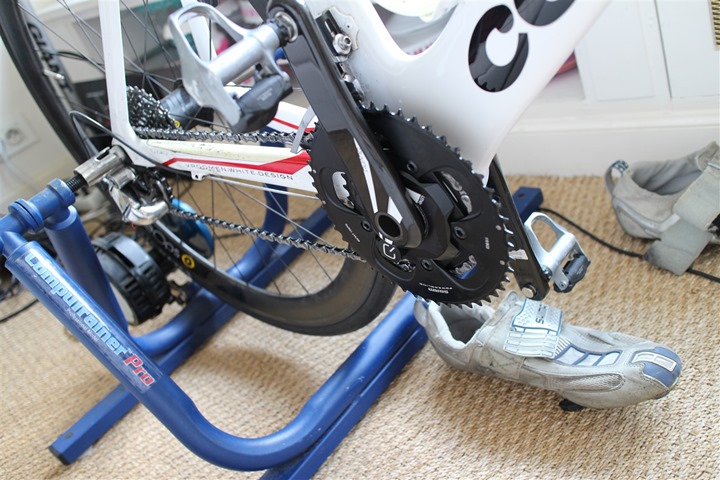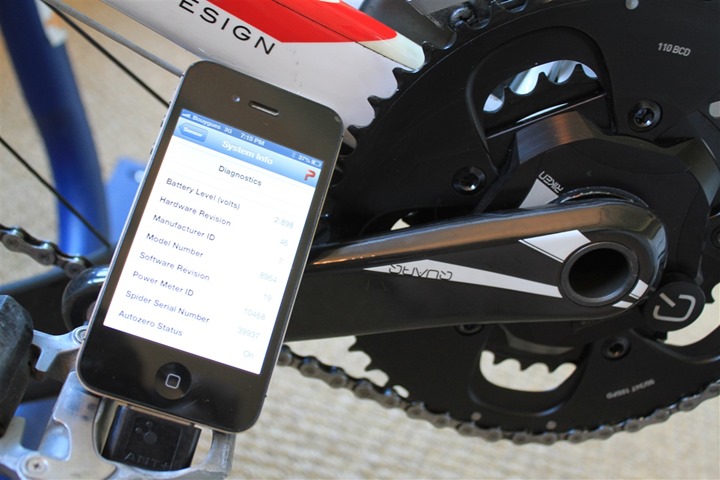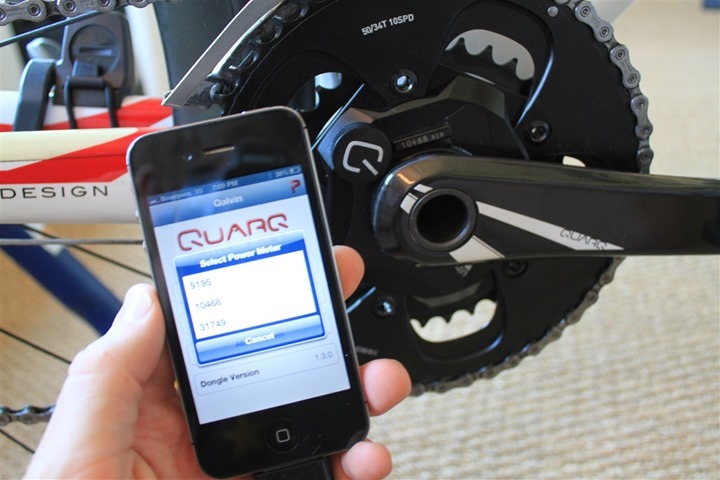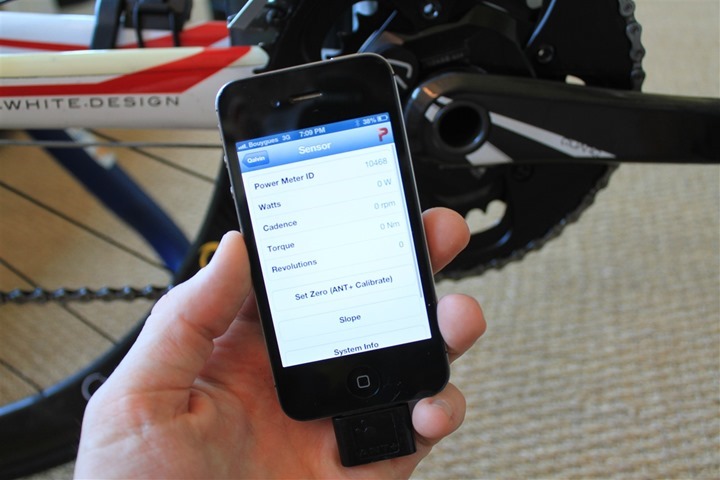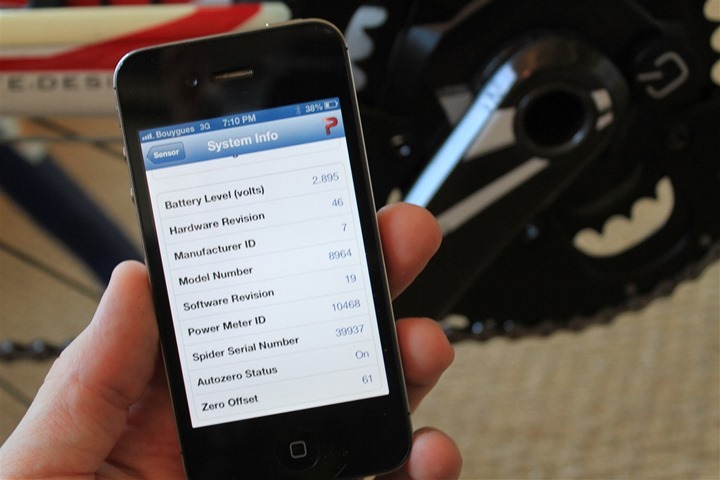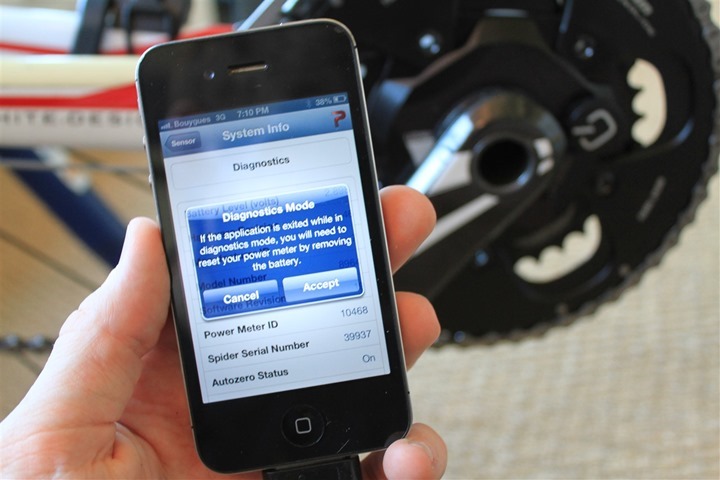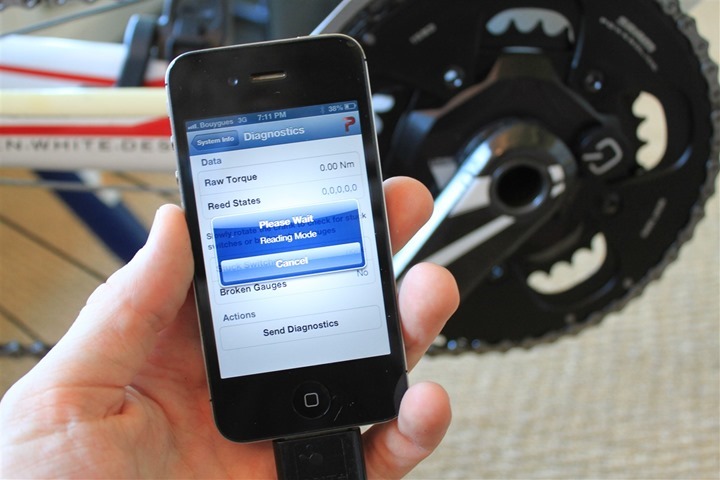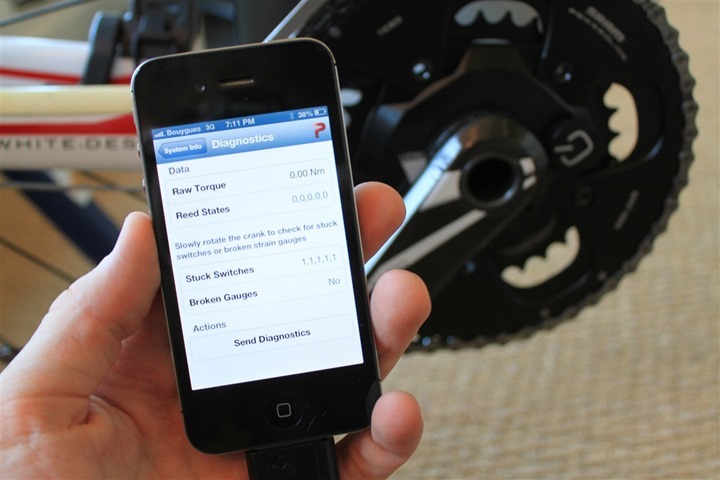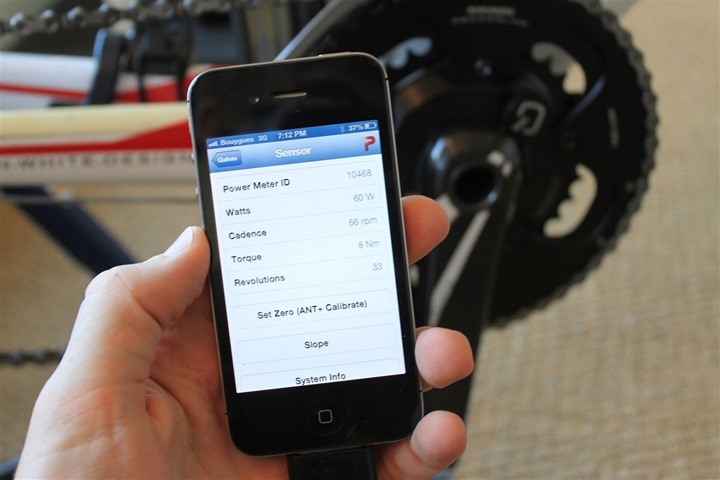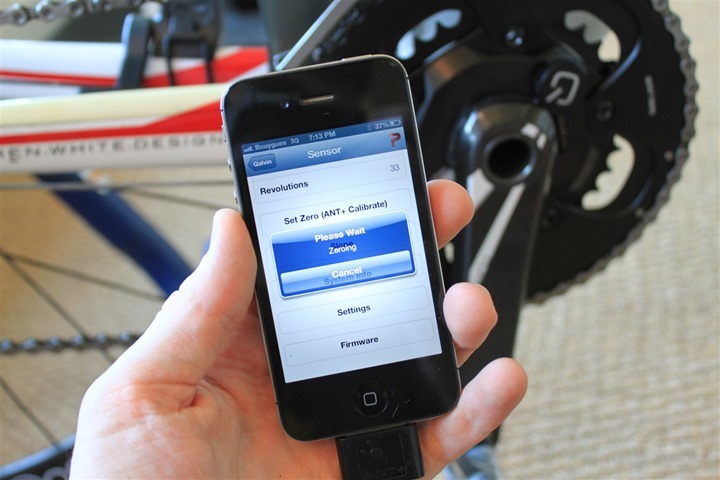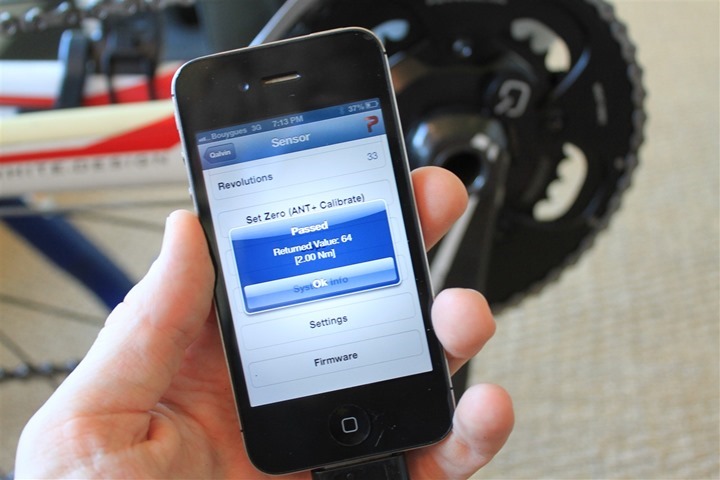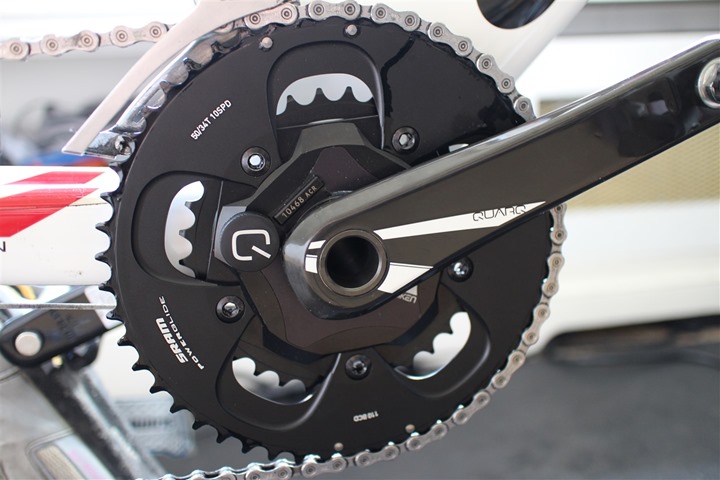Back in the spring Quarq announced their latest additions to the power meter lineup by unveiling the Riken and Elsa power meters. The Riken unit replaced the previous Cinqo units, while the Elsa units acted as a non-SRAM RED option with similar features (SRAM purchased Quarq over two years ago). You’ll find many features on the ELSA that were debuted a year earlier on the SRAM RED.
In early June my previously purchased 5-year old Quarq Cinqo went in for service, and since the unit had been discontinued it ended up being swapped out for the Quarq Riken (per their normal support policy). As such, I figured it’d make sense to put together a product review on it since I’d received many requests for such a review.
Over the course of the summer with riding roughly every other day, both inside and out, I’ve had a pretty good chance to get a feel for how it works – where it differs from past units, and how it compares against the onslaught of units available today. With that, let’s dive into things!
Unboxing:
The Riken unit comes in a box designed specifically for the crank and attached power meter. Just as below:
In the event you aren’t sure what type of product you’ve ordered, the text on the side reminds you:
And, should you wish to harken back to the days of red pill/blue pill and The Matrix, the other side of the box brings you there:
Meanwhile, opening up the top we’ll find all our goods inside:
I’ve gone ahead and taken everything out of the box and placed it below. You’ll see we’ve got the Riken pre-attached to the chainrings, some paper stuffs, and then the left crank arm. Attached to the crank arms you’ll find lots of little parts that you’ll not want to lose.
On this arm we’ve got small washers that you can use depending on your specific pedals:
Here’s the arm without the plastic baggie protecting it:
Meanwhile on the other crank arm we have another flotilla of plastic bags rubber banded to it:
This whole fleet is primarily magnets and magnetic related items. Lots of different variations depending on your specific installation plan. You’ll see we’ve got putty for magnets going straight onto the frame, a magnet that attaches to said putty, a magnet that mounts behind your bottom bracket, and a magnet that sticks out below the frame. No matter how you slice it, you’ll need one of these magnets.
Finally in our unboxing – the Riken itself:
You’ll notice the battery compartment hanging out under the big “Q”, as well as the ANT+ ID to the right of that. If you look where the word “RIKEN” is written down lower, you’ll see the tiny dot for the light. I’ll talk more about that later.
Meanwhile, flipping it over, we’ve got the backside showing clearly where the magnet needs to align to trigger the sensors. The Quarq uses this not only to measure cadence, but most importantly to use that cadence information to determine power. No magnet, no love.
With that, let’s get right into installation. Note however, like most bike parts – it’ll never quite look again as perfectly pretty as it does post-unboxing. So feel free to soak that view in now if you have to.
Installation:
In my case I was swapping out one older Quarq unit for the newer one, so things were fairly straight forward. In general, if the Quarq you’ve purchased has the same chainrings and same bottom bracket type, you’ll be able to knock this out in under 5 minutes. If however, you’re swapping other components, then you’ll probably have to spend more time on adjustments. Thankfully in my case I kept it simple by keeping everything the same.
You can see all the parts below. I start off with having everything in one place. No need to run around trying to find things.
Here’s all the magnets again. In my case I’m going to use the “BB Cup Mount” magnet (BB=Bottom Bracket).
First up is getting the left crank arm off my old unit. You can pretty much just use a hex wrench for this.
Once that’s done, it’ll look like this:
Now I wasn’t terribly smart when I did this for the photos in that I took off my pedals after I had taken off the cranks. I assure you, that’s making life more difficult than need be. Always take off the pedals before you remove the crank arms – that way you can simply hold the other side and keep things in place. Otherwise you won’t have much leverage and it’s like trying to break a circular cactus in half while holding it. Note: The cactus being chain rings.
Once you’ve removed the non-drive side (that’s the side without the chain rings), then you should be able to simply pull the drive side (with chain rings) straight out and off. You can see the bottom bracket, where the unit was previously located:
Next we’ll need to install the cadence magnet. I’m using the BB mounted one because that way I never have to worry about it falling off. My wife used the putty version originally but it fell off (not quite clear how). Now she uses the under frame variant (she has a Trek Speed Concept and the BB variant wouldn’t fit).
In my case, I already had mine on there – so I short-circuited having to take off the BB cups. No matter your installation method, I highly recommend that before applying any sort of putty/glue that you do a quick test run and ensure everything fits without anything dragging or catching.
Once you’ve got it installed, it’ll look like the below. In my case, the tiny Quarq “Q” sticker has long since fallen off. Not that it matters as nobody should ever see it there (if they did, things have gone horribly wrong).
The real point of the photo below however is to call out the placement of my chain. As one who has left it on the wrong side of that bottom bracket before – nothing sucks more than realizing you forgot to put the chain in place before you tightened everything down.
Next, grab the Quarq and remove the cap. It doesn’t get to go for a ride.
Then, simply stuff the whole thing through the hole. Ensure (again) that the chain is in a position to be lifted onto the chain rings (no need to do it yet). Also ensure that if you spin the crank arm, it’s not dragging on anything. Finally, at some point it should have triggered the little red light. Before you proceed, ensure the red light has lit up (spin it backwards to get it to light up). That validates your magnet is ‘firing’.
Assuming all is good on that side, go ahead and attach the crank arm to the other side. I use a hex wrench initially, and then a torque wrench to the proper torque.
And lastly, attach your pedals to both sides if you haven’t yet. And drop your chain back onto the chainring.
With that, you should be ready to move on. In general, I always recommend that if you have a trainer, do some easy pedaling to validate nothing is dragging nor feels (or sounds) weird. If you lack a trainer, just take it for a super-easy pedal stroll around the neighborhood. The goal here is simply to ensure if you’ve hosed up installation you don’t find out doing 300w and 25MPH. Finding out at 8MPH and 75w is a much better proposition.
Finally, we’ll get into calibration and first ride in a minute or two. However, it’s worth nothing that Quarq recommends that you do a handful (such as four) hard standing sprints to ensure everything is settled. Further, they note (and I found this as well in my testing), that it takes about 2-3 rides for the Riken to ‘settle out’ – meaning, for the power values to normalize. So keep that in mind if you install it prior to a Saturday morning long ride and see numbers that seem a bit off.
ANT+ Compatibility and Pairing:
The Quarq Riken is ANT+ compatible, which means it works with just about every ANT+ compatible power meter head unit on the market today. That could be a Garmin unit, a PowerTap unit, or a something else entirely like Magellan, O-Synce, or Timex units. The key is that is supports the ANT+ Power Meter Device Profile; as long as it does that, then you’re good to go.
Pairing with the Riken is pretty straight forward. You’ll dive into your bike settings on your computer and select power meters, then select to search/scan for it.
Once that’s done the unit will show as connected to the sensor. You’ll notice how the “Sensor ID” matches the ANT+ ID located on the crank-arm itself. If for some reason you pickup another ID, then someone else is nearby with a power meter. You can always just manually enter the number in instead.
Back on the main screen you’ll be able to manually set zero (aka calibrate) the unit. I go more deeply into this later, but the quick gist of it is that you’ll want the drive-side crank-arm down for the best possible results.
It’ll come back to you with a number. The number itself isn’t terribly important. What is important is that it doesn’t shift significantly from day to day. A total of 50 units of shift is about the max you’d ever want to see. Most rides I see perhaps a dozen or so units.
Day to Day Use:
In the next few sections I’m going to cover some basics for day to day use, before we talk about things like accuracy and the like.
Starting a ride:
While you can simply jump on your bike and start riding with no interaction with the power meter, you’ll likely want to take about 10 seconds to get it all calibrated first.
I go into this ‘step-by-step’ in the calibration section, but to do so you’ll simply place the drive-side crank arm down (closest to the ground) and then on your bike computer trigger calibration. It only takes a few seconds to complete.
Then, typically about 10-20 minutes into the ride (especially outdoor rides), go ahead and pedal backwards 4-5 times to trigger an auto zero. This helps in the event of any significant temperature changes.
Regardless of whether or not you calibrate (p.s., you really should), the unit is awaken from sleep as soon as you rotate the crank, so it’s immediately ready to roll.
If you’re doing a triathlon, I’d recommend doing the calibration in the morning when you get to transition. Then, once on the bike leg, a couple of miles down the road go ahead and just back pedal the 4-5 times. You’ll be good to go.
What it displays and records for later use:
While riding, the Quarq Riken will transmit the following data to your head unit:
– Power (current watts)
– Cadence (RPM – revolutions per minute)
It does not transmit your speed, as it has no way of measuring it. As the current power and cadence are transmitted, different head units can go ahead and process that information differently. For example most head units on the market offer some form of data smoothing. This isn’t data smoothing of the recorded data stream, but rather just the visible data stream.
This is because power meter data is inherently jumpy, using a 3-second (3s), 10-second (10s), or 30-second (30s) display field can make the data more useful to pace against.
By jumpy, I mean that even if you’re pedaling perfectly steady-state (200w) you’re going to likely see numbers such as: 204, 187, 202, 213, 199, 188, 198, and so on…. That’s normal – every power meter on the market today works that way.
Personally I use a 10s display field as my ‘instant’ power, and a 30s display field as my current trending power. For a triathlete doing what are essentially time-trials, I’m rarely making massive bursts of power to bridge a gap or the like. For those roadies that are however, you may want to swap out that 10s for the 3s power.
Later, after completing your ride you’ll get your power and cadence information to analyze. For example, you can see the most basic application for power analysis – Garmin Connect (here’s my ride file for those curious):
Additionally, in most apps you’ll get power summary information as well:
Personally, I primarily use TrainingPeaks online to manage my training log files. But there are other applications like Golden Cheetah, SportTracks, WKO+ (new version this fall), Strava and numerous others.
Changing batteries:
Swapping the batteries after the 300 hours of normal use on the Riken is about as easy as it gets for a power meter. No tools required, not even a coin to open the doors. Simply grab ahold of the “Q” that holds the battery compartment and twist.
Inside you’ll find yourself a standard coin cell CR2032 battery. Easily replaced anywhere in the world for a couple of dollars.
Simply swap out the battery and then pop the little cap back onto your PM.
The Little Red Light:
Last but not least on the ‘good things to know’ bucket list is the little red light on the side of the Riken:
The light displays briefly in a few different conditions – but the most useful of which is that it tells you that the unit has turned on. Why is that useful? Well, a few reasons. First, if you can’t figure out why power isn’t transmitting, at least you can see if the unit is even powered on. Second, because the Riken requires installation of a magnet to get power, the little light won’t turn on unless the magnet has been ‘tripped’. Which means – if you glued your magnet on, and it had somehow fallen off, you won’t get a light anymore.
Additionally, it also triggers in a few other use cases:
– When popping the battery in
– When woken up (turning on)
– Upon zero completion (calibration)
– When it’s tired and is heading to sleep
– You can use it to perform a self-test (details in manual)
Note that the unit falls asleep after 10 minutes of inactivity. Simply turning the crank will wake it up.
My general rule of thumb with 5 years of owning a Quarq unit is that if my head unit isn’t connecting to the Quarq, then basically 100% of the time the battery has gone dead. So simply swap it out and you’ll be good to go. Previously, without the lights you had to guess at whether the battery is dead. Now it’s sorta obvious: No light, no juice.
Power Meter Accuracy:
I often note that there are few things I despise more than doing in-depth power meter accuracy tests. Primarily because it’s excruciatingly difficult to do correctly (especially in a non-lab environment), and because nobody is ever happy with how you executed the test. The reason being that you have to correlate multiple power meter files from multiple head units, and hope that all head units operated properly every time. No skips, jumps, crashes, or other funkiness.
For example – are all units installed correctly? Are all units calibrated (correctly) at the start of the ride? Are they re-calibrated and/or zero offset updated at some point after the unit warms up? Are they all started at exactly the same time? Same recording rates? Do any units auto-pause (like the Joule) once started? If you stop mid-ride, are they all stopped at the same time (Tip: never stop)? How is change in weather or temperature affecting it?
In the case of the Riken, I was tracking power with 3-4 different power meters, depending on whether I was indoors or outdoors. For outdoor tests, the following units were being used:
– Quarq Riken
– PowerTap G3
– Stages Power Meter
While indoors, the tests also included one of the following:
– CompuTrainer Pro
– Wahoo Fitness KICKR
From a testing methodology standpoint all units are manually calibrated at the start of the the ride. Then again about 15-20 minutes into the ride I’ll stop and do another manual calibration (zero offset). From there, I let each unit’s internal technologies deal with correction/compensation. I have two different options available to me for gathering data. The first is to gather data concurrently with multiple head units. In my case I primarily use the Garmin Edge 800 and Edge 810 to do so. Second is the use of the NPE WASP unit to concurrently gather all ANT+ data being transmitted.
In the case of this review I’m going to look at three rides out of the larger set of rides. Indoor and outdoor rides serve different purposes from a testing standpoint. Outdoor rides are great at identifying issues that may pop-up with temperature drift, rough roads, or other environmental factors. While indoor rides are good for being able to really put the microscope on the data – especially cadence and steady power data. It’s more difficult to do outside because for most rides you’ll see shifts in power/cadence due to terrain – making it much more difficult to track down errant points.
Indoor Trainer Ride:
Let’s start with something a bit shorter and simpler – an indoor trainer ride. This was part of a longer bike-run brick I was doing (short bike, long run). But it’s a good look into understanding the graphs and some example events that you’ll see.
First up we see that all three units track reasonably close together during the 10-minute warm-up (through 600s below). Then, we see the calibration point – this is the large canyon you see at the end of the warm-up. Following that we get back on track. This particular workout then shifted into a 5-minute high cadence piece. In this particular workout we see very solid tracking between the Quarq and the PowerTap – they basically sit right on top of each other. However what we see is that the Stages deviates a bit more there, likely due to a shift in my left/right balance increasing my right-balance. It’s only heavily prevalent though during the high cadence portion.
Looking beyond that to about the 1000s marker we see the start of my intensity build. In this case the Quarq/PowerTap continue to track spot-on top of each other (for better or worse). However, the Stages tracks consistently as well, just about 10-15w below that. You’ll see it matches the same pattern, even if there’s total wattage variation.
Looking at that variation (below), it shows an interesting story and more importantly shows the impact of calibration. Look at the orange line (Quarq vs PowerTap) and notice how for those first 10 minutes it sits at about 8-10w of difference (the Stages is actually closer then). Then, after I do my calibration you see that the orange line goes down to basically zero. Meanwhile, the Stages jumps up to 10 watts of variation.
Of course, the question becomes – which one is right? Was the pre-calibration or post-calibration right? Well, in this case I’m going to go with post-calibration. And I’m going to guess that the post-calibration jump in Stages power is actually simply my slight right-leg dominance becoming more apparent. And keep in mind – we’re only talking 10w here – on a value of 275w. Or basically a little under 3%. Between the PowerTap and Riken we’re looking at less than 1%. Though, one could argue it should actually be slightly bigger than that. But at that point you’re within the overlapping boundaries of accuracy of both units.
Longer Trainer Ride:
Next, we’ve got the reverse of above, where I was doing a longer ride (1hr 20m) before transitioning to a relatively short run (30ish minutes). This particular brick is great to look at because the bike portion is the always popular 2×20’s – thus allowing for a look at steady-state wattage data.
Let’s start with the 30s smoothed data. I smooth the data because if you look at the 1s data it’s just too many lines to make sense of it.
In this case we see a few things:
The Quarq is reading higher than both the Stages and the PowerTap: This is normal and expected. This is because the PowerTap is further ‘downstream’ than the Quarq, and thus there will be some loss in drivetrain efficiency there. On the Stages side, this also makes sense – because I tend t0 see that my left leg is a bit weaker than my right – so the doubling effect of the Stages reading left-only is visible here.
There are some drops: There does appear to be some interference during this ride. I saw this visually on my head units with it impacting everything from HR to cadence to power. In this case, I’ve highlighted those in yellow above. As you can see, it didn’t spare anyone – as all power meters were impacted by it. It was transient however, whatever was causing it.
All three units do trend well together: If we look at the trending at any given point, they all trend pretty much the same levels apart. Further, we see that when it comes to my significant shifts in power (i.e. my rest breaks), they align spot-on.
So let’s look at the differences there between the Quarq and the PowerTap, and Quarq and the Stages:
So what is this showing? Well, it’s looking at how much variation is occurring between the units. We aren’t necessarily focused on whether a specific power meter unit is +10w different from another, but rather, focused more on whether that +10w is +25w during one portion and +5w during another. Obviously due to the nature of power meters there’ll be slight bumps – but we want the trend to be consistent.
And we tend to see that here. If you ignore the big drops (caused by interference to one or more units), then you see that the overall line stays pretty even between the Quarq and the PowerTap (orange). We see a bit more variation between the Stages and the Quarq (blue) – likely the result of the leg-left measurement and slight shifts in the balance there.
Finally, here’s the TSS/NP/IF for this ride based on the recordings done:
Which power meter is ultimately correct is much harder to figure out without additional units that fully measure both legs.
Outdoor Ride:
In this ride I was riding mostly steady-state loops around a local horse track (Longchamps), which afforded me a nice way of looking at data loop after loop in keeping a reasonably steady effort.
As we start out this ride you see a bit of ups and downs as I cross the city for the first 25-30 minutes (about the 1500-second marker), but even during that phase, things stayed pretty ‘tight’ between the three units.
As I hit the 1500 marker I started my loops around an area popular for local cyclists (without cars) you see my wattage stabilize. You can see the ‘dips’ on each loop – which is a short downhill section that ends up being a brief moment of coasting – hence the drop of power. Through this entire process we see all three units tracking right on top of each other. Towards the end of the ride I start to work my way back – about the 5700 marker or so. This is where you see more variation again in the wattage as I cross the city. You see five big spikes which were some short 30-second intervals I did.
Looking at the difference between the units we see high levels of variations in the first 25 minutes – in particular between the Stages and the Quarq. The reason for this is the stop and go nature of crossing the city and the impact that has on slight transmission and recording delays because of how each unit works. With the constant stop and go those changes become exaggerated.
However, once you get within the steady-state portion things become much more aligned. I’ve highlighted this area with the two yellow brackets below.
Looking primarily at that section we see that between the Quarq and PowerTap (Orange) that the vast majority of the time it stays within 10w – which is very solid. We don’t see any shifting up or down of that either – the difference ‘centerline’ if you will remains about +7 or so watts across that entire section.
Finally, here’s the Averages/Max’s/TSS/NP/IF for this ride based on the recordings done:
Looking at this ride, there’s great commonality between the Quarq and the PowerTap.
Accuracy Summary:
Ultimately when you’re comparing two different types of power meters, you’re going to get variations in power output. There’s no getting around that. If you were to put both a Quarq and an SRM on a bike at the same time (physically impossible), you’d likely get near perfect alignment of numbers.
Thus, in the case of any power meter, you want consistent numbers that are accurate to the appropriate location on the bike.
With the Riken I saw consistent numbers across the board – and numbers that were accurate within the placement of where that power meter was compared to others. As noted in the installation section – you really do need to let it ‘settle out’ a few rides (2-3) before the unit provides consistent numbers day after day. During my initial few ride period I saw a bit more variation between units than I normally would – or did later on. So do keep that in mind.
Calibration Methods:
Quarq (and everyone else in the power industry) recommend that you manually calibrate the unit before every ride for the highest level of accuracy. Below are the two main types of calibration-like activities that the Quarq supports.
Quarq Manual Calibration (Setting Zero Offset):
1) Unclip from bicycle, leaving no force on the pedals (in other words, no shoes/feet on the pedals).
2) Place the crank arm in the vertical position (one arm up, one arm down). Quarq recommend placing the drive side down (vertical).
3) On the head unit, navigate into the calibration menus and select to ‘Calibrate’.
4) Calibration will come back with ‘Successful’.
The value will be returned somewhere between -1000 and +1000. The exact placement of that value isn’t terribly important. What’s more important is that if the value moves day to day more than 50 units – which indicates something may be up with the power meter (and to ring Quarq).
Quarq Auto Zero:
In addition to manual calibration, there is also ‘auto zero’ functionality. Auto zero is triggered anytime you backwards pedal for 3-4 complete revolutions. Over the course of a ride, Quarq recommends you complete this any time conditions change significantly (primarily temperature), or prior to any testing efforts (i.e. FTP test, etc…).
1) Ensure auto zero is enabled within your bike computer (usually is by default)
2) While coasting, pedal backwards 3-4 complete revolutions. All backpedaling revolutions should be done in one shot, as the unit will actually retain partial revolutions (i.e. if you did one revolution now, and another few later, it’ll use the data from both). Thus it’s best to just complete 4 revolutions in one single shot.
3) On the newer Quarq units (Elsa/Red/Riken), a red light will flash on the unit itself letting you know this has been completed. Though seeing this light while riding is pretty hard to do. Otherwise, no end-user viewable message is given.
In general I try and remember to backpedal occasionally if I’ve changed environments or temperature zones significantly during a ride (such as climbing). This is easy to do if coasting, such as coming up on a stoplight or down a hill.
Finally, in addition to the above modes, the Riken also supports a more in-depth hanging-weight test using the Quarq Qalvin app discussed…well, next.
Quarq Qalvin iPhone App:
Quarq is the only unit on the market today to offer an iPhone (and Android) app that allows you to dig into your power meter a bit more. For most users, this won’t really be of much use. And in fact, I generally wouldn’t recommend you mess around with it unless you’ve got a specific item you’re trying to address. Otherwise it can be a bit like playing with fire.
Nonetheless, here’s the quick tour of the app.
First up, you’ll need the Wahoo Fitness ANT+ iPhone adapter. This works natively with the iPhone 4s and older, but also works just fine with the Lightning adapter.
Upon launching the app it’ll do a quick search of nearby power meters. You’ll probably only see one, thus making the choice fairly straight forward.
After connecting to it you’ll see the main overview page showing information such as your ANT+ ID, current watts, torque, cadence and revolutions. Below that are further options.
If you dive into the System Info page you’ll get similar info to what can be enumerated on some ANT+ bike computers:
Diving into the diagnostics mode you’ll briefly accept a warning with instructions for how to get it out of diag mode if something goes wrong.
It’ll then go ahead and read information from your unit:
Once that finishes it’ll return a fairly straightforward list of details. Again, for the most part here you aren’t going into this to choose your favorite color or anything. This is really more for fixing something that’s broken.
You can however toggle whether or not Autozero is enabled (unless you know what you’re doing, with a specific purpose, leave it on). You can also toggle whether or not wattage and cadence are calculated when pedaling backwards.
Finally, as we dive further we can perform a Set Zero – which is basically the same commands an ANT+ head unit transmit to it to calibrate:
It’ll take a moment to complete:
Note that the app does work on Android, but requires a device with ANT+ built in, such as the Sony Xperia Active, and just announced Samsung Notes with ANT+ contained within them. Do note that on Android phones with ANT+, you’ll need to finagle a bit with the version of the ANT+ Radio Service, because Quarq hasn’t updated their Android app in such a long time that it’s no longer compatible with the current version.
It also allows you to update firmware in the event customer service points you in that direction. It’s not so much used as proactive firmware updating (i.e. new features), as it is for reactive firmware to address a specific issue.
All that said however, the app is a cool and welcomed addition – especially being the only power meter company to release an app dedicated to diagnostics and servicing of a direct force power meter.
Power Meter Market Comparison:
Tuesday I walked through the entire power meter market as it will stand for some time in the future, as there are no other power meters outside that post on the horizon until at least next spring (at the absolute earliest). So I really encourage you to read that post, as I outlined a lot of different scenarios and recommendations – as well as answered a slew of questions in the comments.
With that said, here’s a dynamic comparison chart of the major power meters on the market today that I’ve reviewed. My rule is that if I haven’t reviewed it, it doesn’t go in the chart. Hence why SRM isn’t in there. Remember to click the “expand” button to see all the rows (there’s a crapton of them).
| Function/Feature | Quarq Riken R | Favero Assioma Pro MX Pedals | Wahoo POWRLINK ZERO (Dual-sided) | Favero Assioma DUO-Shi (Shimano) Pedals | Garmin Rally Series | ||||||||||||||||||||||||||||||
|---|---|---|---|---|---|---|---|---|---|---|---|---|---|---|---|---|---|---|---|---|---|---|---|---|---|---|---|---|---|---|---|---|---|---|---|
| Copyright DC Rainmaker - Updated February 20th, 2024 @ 3:34 am New Window | |||||||||||||||||||||||||||||||||||
| Price | $1099 (with cranks, no chainrings) | $499/$750 | $649/$999 | $459/$719(single/dual) | $649/$1,099 (SINGLE/DUAL) | ||||||||||||||||||||||||||||||
| Available today | Yes | Global | Global | Global | Global | ||||||||||||||||||||||||||||||
| Measurement Type | Direct Force | Direct Force | Direct Force | Direct Force | Direct Force | ||||||||||||||||||||||||||||||
| Attachment area | Crank Spider | Pedal | Pedal | Pedal | Pedals | ||||||||||||||||||||||||||||||
| Attachment limitations | Specific supported cranks | Shimano SPD Cleats | Speedplay cleats | Shimano SPD-SL Road Pedals | SPD/SPD-SL/LOOK KEO | ||||||||||||||||||||||||||||||
| Weight (additional/net) | From 659g (including cranks) | 191g per pedal | 133g per pedal (plus cleat weight) | 150g per pedal (inclusive of pods) | 159g SPD-SL/165g KEO/221g SPD | ||||||||||||||||||||||||||||||
| Wireless Connectivity Type | ANT+ | ANT+/BLUETOOTH SMART (DUAL) | ANT+/BLUETOOTH SMART (DUAL) | ANT+/BLUETOOTH SMART (DUAL) | ANT+/Bluetooth Smart | ||||||||||||||||||||||||||||||
| Unit auto-turns on when on bike | Yes | Yes | Yes | Yes | Yes | Battery | Quarq Riken R | Favero Assioma Pro MX Pedals | Wahoo POWRLINK ZERO (Dual-sided) | Favero Assioma DUO-Shi (Shimano) Pedals | Garmin Rally Series | ||||||||||||||||||||||||
| Battery Life | 300 hours | 60 Hours | 75 Hours | 50 Hours | 120-150 hours | ||||||||||||||||||||||||||||||
| User or Factory battery replacement | User | FACTORY (SUPPORT ISSUE ONLY) | FACTORY (SUPPORT ISSUE ONLY) | FACTORY (SUPPORT ISSUE ONLY) | User | ||||||||||||||||||||||||||||||
| Battery type | CR2032 | Rechargeable | Rechargeable | Rechargeable | CR3/1N | ||||||||||||||||||||||||||||||
| Low Battery Warning | Yes | Yes | Yes | Yes | Yes | Features | Quarq Riken R | Favero Assioma Pro MX Pedals | Wahoo POWRLINK ZERO (Dual-sided) | Favero Assioma DUO-Shi (Shimano) Pedals | Garmin Rally Series | ||||||||||||||||||||||||
| Measures/Transmits Cadence | Yes | Yes | Yes | Yes | Yes | ||||||||||||||||||||||||||||||
| Ability to update firmware | Qalvin App & USB ANT+ Stick | Yes | Yes | Yes | Yes | ||||||||||||||||||||||||||||||
| Transmits Left/Right Power Balance (Estimated) | Yes | N/A | N/A | N/A | N/A | ||||||||||||||||||||||||||||||
| Transmits Left/Right Power Balance (Measured) | No | Yes | Yes | Yes | Yes | ||||||||||||||||||||||||||||||
| Transmits Pedal Smoothness | No | Yes | No | Yes | Yes | Accuracy | Quarq Riken R | Favero Assioma Pro MX Pedals | Wahoo POWRLINK ZERO (Dual-sided) | Favero Assioma DUO-Shi (Shimano) Pedals | Garmin Rally Series | ||||||||||||||||||||||||
| Measures all power output | Yes | Yes | Yes | Yes | Yes | ||||||||||||||||||||||||||||||
| Claimed Accuracy Level | +/- 1.5% | +/- 1% | +/- 1% | +/- 1% | +/- 1% | ||||||||||||||||||||||||||||||
| Includes temperature compensation | Done at factory | Yes | Yes | Yes | Yes | ||||||||||||||||||||||||||||||
| Supports auto-zero function | Yes | Yes | Yes | Yes | Yes | ||||||||||||||||||||||||||||||
| Supports manual calibration | Yes | Yes | Yes | Yes | Yes | ||||||||||||||||||||||||||||||
| Supports hanging weights (static test) | Yes | Yes | No | Yes | Yes | Software | Quarq Riken R | Favero Assioma Pro MX Pedals | Wahoo POWRLINK ZERO (Dual-sided) | Favero Assioma DUO-Shi (Shimano) Pedals | Garmin Rally Series | ||||||||||||||||||||||||
| Phone App to Configure/Test | Yes | Yes | Yes | Yes | Yes | Purchase | Quarq Riken R | Favero Assioma Pro MX Pedals | Wahoo POWRLINK ZERO (Dual-sided) | Favero Assioma DUO-Shi (Shimano) Pedals | Garmin Rally Series | ||||||||||||||||||||||||
| Amazon | Link | Link | Link | ||||||||||||||||||||||||||||||||
| Backcountry.com | Link | Link | |||||||||||||||||||||||||||||||||
| Competitive Cyclist | Link | Link | |||||||||||||||||||||||||||||||||
| REI | Link | Link | |||||||||||||||||||||||||||||||||
| TPC | Link | Link | |||||||||||||||||||||||||||||||||
| Other | Link | DCRainmaker | Quarq Riken R | Favero Assioma Pro MX Pedals | Wahoo POWRLINK ZERO (Dual-sided) | Favero Assioma DUO-Shi (Shimano) Pedals | Garmin Rally Series | ||||||||||||||||||||||||||||
| Review Link | Link | Link | Link | Link | Link | ||||||||||||||||||||||||||||||
The benefit of the above chart is that over time as firmware updates add features to other units it will be updated.
For those looking for information on the ROTOR power system, they’re aiming to get me a unit in late September 2013, and thus I’ll likely have a review closer to November sometime. My thoughts regarding ROTOR however are included in the power meter market post as well above.
Summary:
There’s no doubt in my mind that the Riken is a solid power meter, capable of helping any athlete train. I saw consistent accuracy, and day to day use is spot-on with any other top power meter on the market.
While it lacks left/right functionality of some more expensive and/or newer units, there still remains much disagreement about how to truly use that data in a training setting – and what value that data offers. No doubt in time smart folks will figure that out – but today that guidance lacks definition.
The addition of the troubleshooting/status LED, and extended features found in the Qalvin app are unique to the Quarq lineup and can be genuinely helpful in getting yourself out of a pickle.
My single concern with the unit is really pricing, and where things stand relative to the rest of the market with the price as it stands here in early September ($1,600US). Rather than re-hash it, I talk about this extensively in my power meter market comparison.
As always, if you have any questions feel free to drop them below. Thanks for reading!
Found this review useful? Here’s how you can help support future reviews with just a single click! Read on…
Hopefully you found this review useful. At the end of the day, I’m an athlete just like you looking for the most detail possible on a new purchase – so my review is written from the standpoint of how I used the device. The reviews generally take a lot of hours to put together, so it’s a fair bit of work (and labor of love). As you probably noticed by looking below, I also take time to answer all the questions posted in the comments – and there’s quite a bit of detail in there as well.
I’ve partnered with Clever Training to offer all DC Rainmaker readers an exclusive 10% discount across the board on all products (except clearance items). You can pickup the Quarq Riken below. Then receive 10% off of everything in your cart by adding code DCR10BTF at checkout. By doing so, you not only support the site (and all the work I do here) – but you also get a sweet discount. And if you happen to spend more than $75 (which you would), you get free US shipping as well.
Additionally, you can also use Amazon to purchase the unit (though, no discount). Or, anything else you pickup on Amazon helps support the site as well (socks, laundry detergent, cowbells). If you’re outside the US, I’ve got links to all of the major individual country Amazon stores on the sidebar towards the top. Though, Clever Training also ships there too and you get the 10% discount.
Thanks for reading! And as always, feel free to post comments or questions in the comments section below, I’ll be happy to try and answer them as quickly as possible. And lastly, if you felt this review was useful – I always appreciate feedback in the comments below. Thanks!
Finally, I’ve written up a ton of helpful guides around using most of the major fitness devices, which you may find useful in getting started with the devices. These guides are all listed on this page here.


